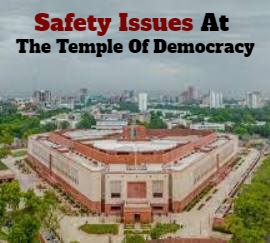

By Our Editorial Team
First publised on 2023-12-15 07:37:24
Three things emerge from the scary and dangerous security breach at the new parliament building. One, the revised security protocols, after the 2001 terrorist attack on the old Parliament building were not well thought out and are not effective to deter such intrusions and attacks. Two, the recent review of the security protocols, after US-based Sikh separatist Gurpatwant Singh Pannun issued a threat to the Parliament, was not thorough. Three, the new Parliament building, where the height of the visitor's gallery is too low making it possible for people to jump in the chamber, was not designed with the security angle in mind. Also, as a side issue, the guidelines of MPs issuing passes to visitors needs to be revised.
Most of the revised security protocols in place in the old Parliament building must have been applied to the new Parliament building with adjustments for size and newer entry and exit points. But the ease with which the smoke attackers could carry canisters in their shoes shows that these protocols were not robust otherwise the machines would have beeped on detecting metal in the shoes. This shortcoming has come to notice due to the attack. There must be others. Hence, a complete overhaul has become necessary, with mock drills when the Parliament is not in session. Then, after the threat by Pannun, there was a review of the security protocol. Just a few weeks after that, a bunch of amateurs showed that it could be breached. Then what kind of review was carried out? Also, the height of the visitor's gallery in the new Parliament building is too low. The designers did not factor in the security threat from visitors jumping in the House from there. Now it has been decided to enclose it. It should have been done at the designing stage. Although 8 Lok Sabha security staff have been suspended, if machines did not beep on detecting metal in shoes and if checking shoes separately was not in the security protocol, the persons manning the gates and allowing entry to visitors were not really at fault. The probe by the committee headed by Anish Dayal Singh, the DG of CRPF, while reviewing the security protocols and the reasons for the lapse, must fix responsibility and recommend appropriate punishment for the guilty.
While the guidelines governing issue of visitor's passes need to be revised, it must be kept in mind that in a democracy, common citizens must be allowed to witness how Parliament functions. Although the proceedings of both Houses are now televised live, the experience of watching it first hand from the visitor's gallery is awesome. Hence, neither should the guidelines be so tough as to make it impossible for people to obtain passes nor should the visitor's gallery kept closed indefinitely. Incidents like the one that happened on 13th December are dangerous and must instigate measures to make security protocols more robust. But they should not be used as an excuse to deny the common citizens the pleasure of watching their elected representatives' conduct Parliamentary business from close quarters.











